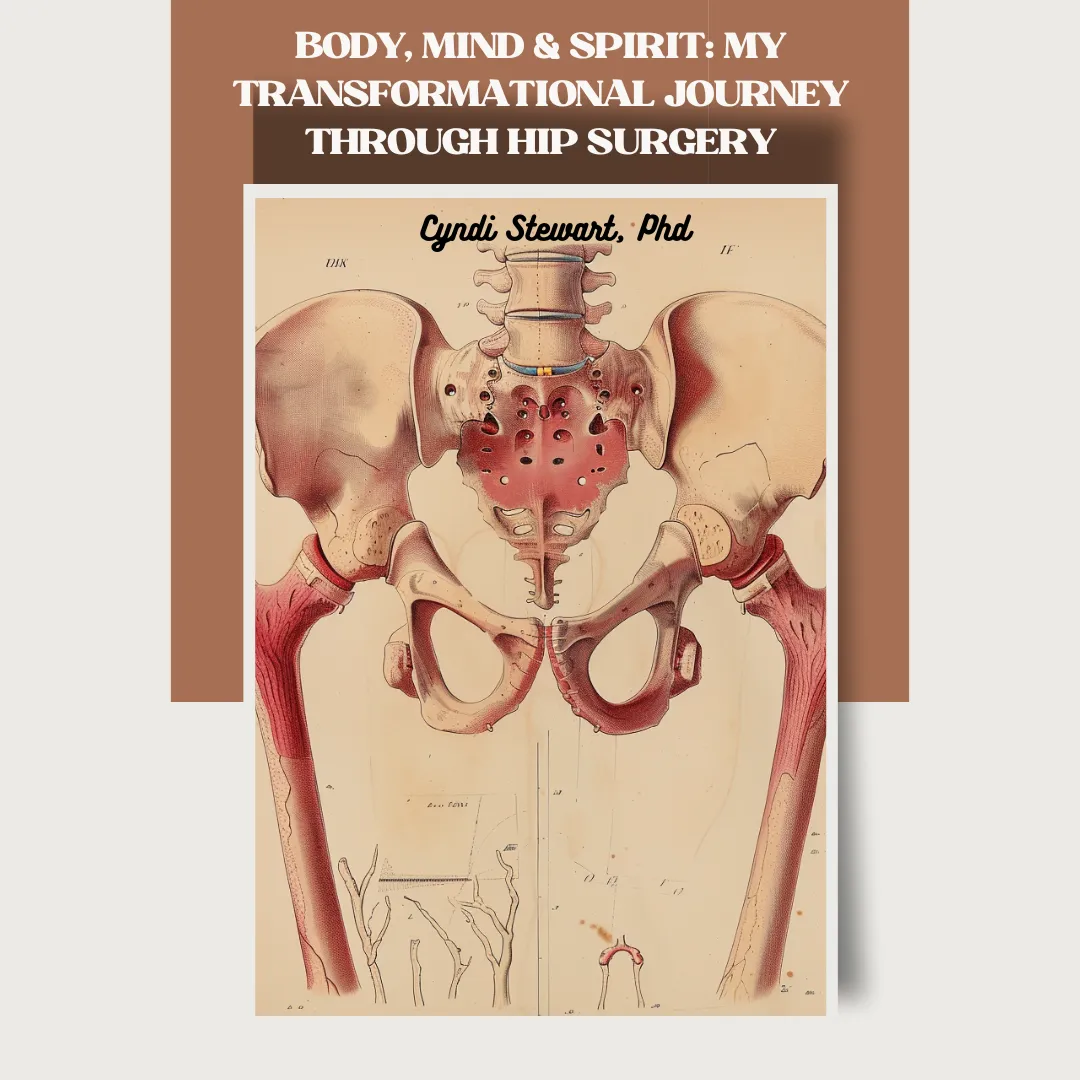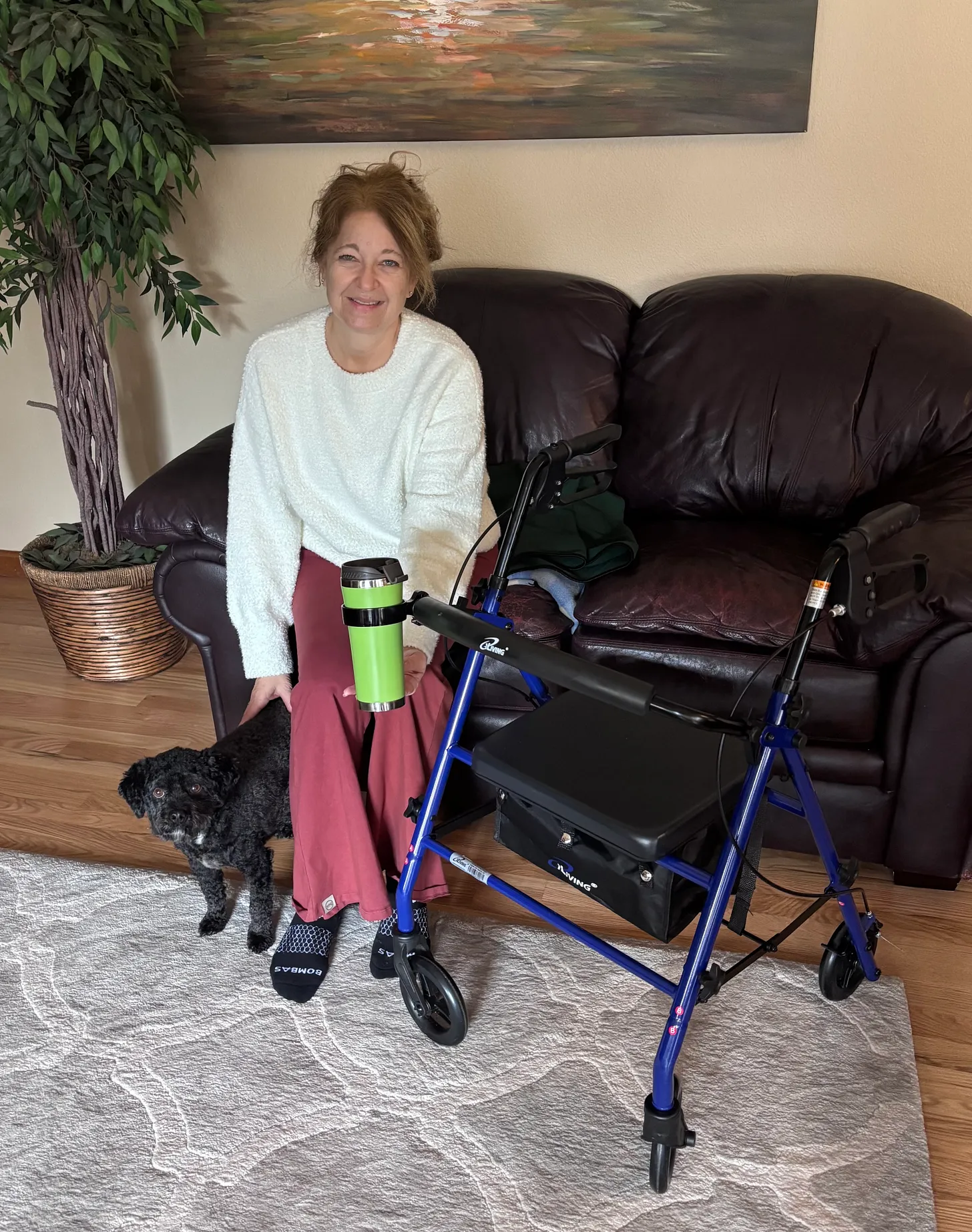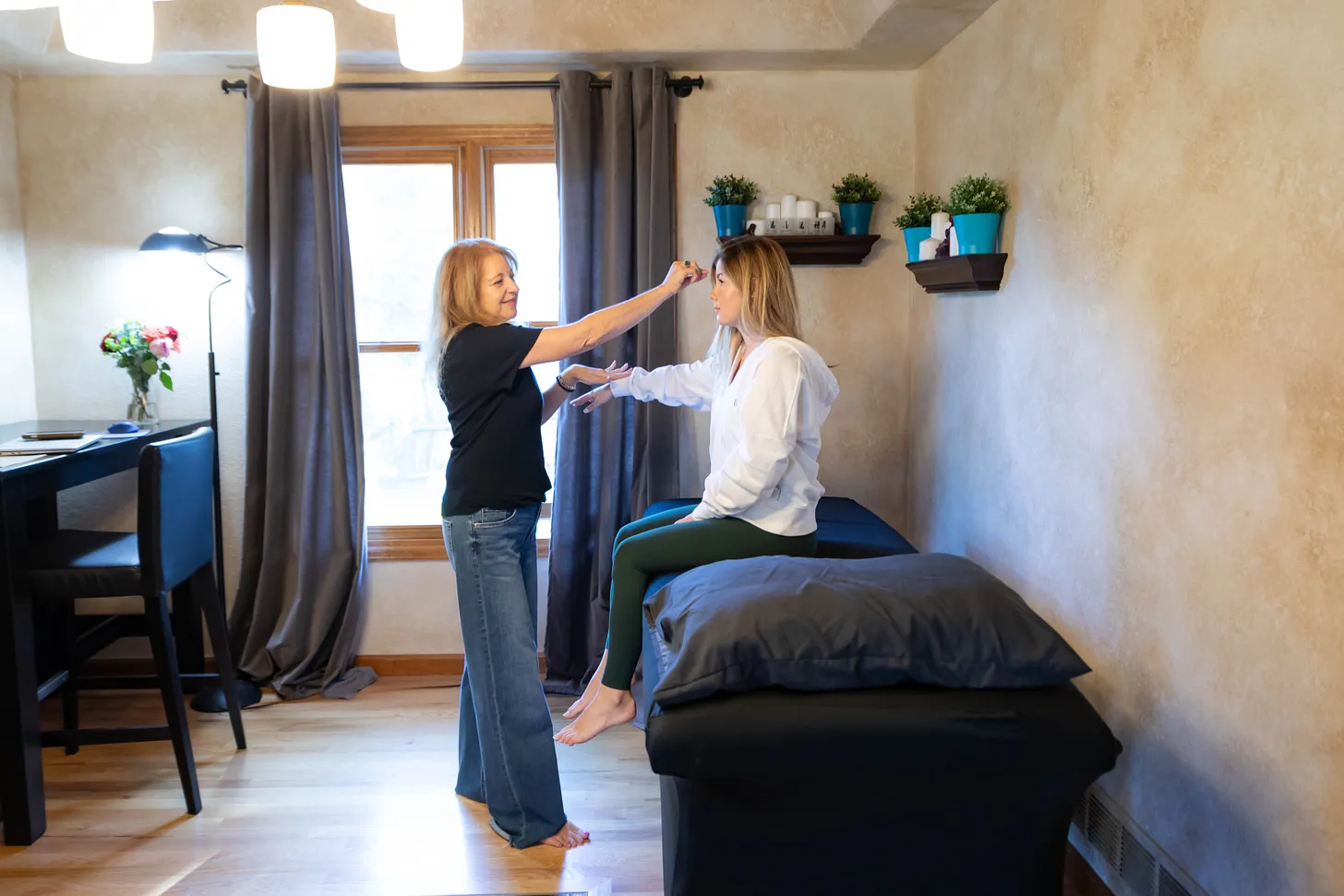Hip Replacement can Signify a Turning Point

One day, your hips are not even a thought; the next, they become all-consuming. If you’re like me, you may have been contemplating hip surgery for some time and are ready to make a decision—or have already made it. I did a lot of different physical and emotional therapies ie physical therapy, massage therapy, cranial sacral therapy, chiropractic care, muscle activation therapy, yoga therapy, EMK (Emotions & Metaphysical Kinesiology), which helped a lot. Unfortunately, once it’s bone on bone, these therapies can’t replace connective tissue.
Once I made the decision to proceed with surgery, I focused entirely on preparing my body for the best possible recovery. I’m sharing my experience because when I searched the internet for insight, my results were bleak. I hope the information provided gives you support and even peace of mind.
A Little About Me
I’ve been on a deep soul journey that includes uncovering who I am, seeking purpose and meaning while releasing limiting beliefs. This transformational journey did include healing my physical body, but not the skeletal system. This is a new topic for me, as I mostly write about topics I experienced through my own health journey such as: Hashimoto’s with goiters and very high antibodies, Panic attacks and using neurotransmitters, Ménière’s disease, Gallbladder removal, MTHFR gene mutation (which can exacerbate Hashimoto’s), Food intolerances and Emotional eating.
What Led Me to Hip Surgery
A labral tear started my journey. I tried various therapies for over two years, but eventually the pain moved down my leg to my foot. Every time I’d exercise, I’d experience pain and inflammation, then take a few days off to recover. I’d feel better, exercise again, and the pattern would repeat. My surgeon explained this is common with bone-on-bone conditions.
My Joy in Life (Movement) Was Impacted
I could have continued this on-and-off exercise pattern, but it was impacting other important parts of my life. My world was getting smaller in terms of what I could do, which affected my happiness. Additionally, my knee and ankle were becoming weaker, and my spinal alignment was consistently off.
Looking Deeper: Hip Issues and Related Emotions
Since I focus on healing through “Body, Mind & Spirit,” I couldn’t ignore these other aspects:
1. Emotions
According to “The Secret Language of Your Body,” hips are tied to family problems and disagreements, feeling unappreciated or deceived, feeling alienated or frustrated, lack of support, too much responsibility and feeling taken advantage of or manipulated
2. Meridians, Chakras & Elements
Hips are tied to the earth and water elements, so they require grounding and inspiration. The gallbladder meridian governs the hips, which is associated with decision-making, courage, and the ability to take action. The root and sacral chakras both hold the energy of the hips and relate to fear and guilt
3. Hip Replacement can Signify a Turning Point
Evette Rose in “Metaphysical Anatomy” shares that hip replacements signify a turning point—a positive movement forward from how you used to feel into how you want to feel.
Looking Deeper into Hip Issues and Related Emotions. Why does this matter?
The mind-body connection is always at play. When our body responds through health challenges or injury, the emotions and subtle energy bodies require healing as well. Unfinished business or unprocessed emotions will appear in other areas of life or in the body, so addressing the whole picture is beneficial.
I recommend reflecting on and journaling about these emotional aspects prior to surgery. I found when emotions aren’t acknowledged and processed, they reappear after surgery.
Preparing for Surgery and Recovery
Two weeks prior to surgery, herbal supplements must be eliminated due to concerns with bleeding and blood clots. This is challenging since the best defense for a successful surgery and recovery is maintaining immune function and reducing inflammation, so I shared below how I addressed it.
My Pre-Surgery Concerns
My concerns weren’t primarily about the surgery itself, even though complications are always possible. Instead, I worried about:
1. Recovery and the unknowns: I heard many stories—some walking after a week, others taking six months.
2. Medications and reactions: Being very sensitive to medications, I was concerned about potential reactions. I’m prone to microbiome imbalances, brain fog, and liver detox issues. I have MTHFR (specifically two copies of the MTHFR C677T variant) and had my gallbladder removed, creating additional processing and elimination challenges.
3. Leg length: If you weren’t informed, the leg will be longer after hip replacement. My leg on the side of the hip being replaced was already longer (or the other was shorter, or my hip was rotated forward) so I was very concerned. Either way, the difference would worsen. (Note: I’ll eventually need to replace the other hip as well.)
How I Prepared My Body for Surgery and Recovery
1. Nutrition and Anti-Inflammatory Focus
I increased my focus on anti-inflammatory foods and nutrients two weeks prior to surgery. Note: If you think this is impossible, I did this during the holiday season since my surgery was the first week of January. Honestly, I felt great eating healthily during those weeks instead of consuming sugary holiday foods. You can do this!
- Drank water with freshly squeezed lemon daily for vitamin C
- Reduced inflammatory foods:
- 1)Dairy, sugar, refined carbs (“the whites”).
- 2) Processed snacks like cookies, pastries, potato chips, French fries, candy
- Eliminated alcohol
- Had a daily green drink (either juice or greens powder.) *Note: Read ingredients carefully—avoid blood thinners such as turmeric, ginger, and cayenne pepper
- Eliminated inflammatory oils and increased olive oil consumption. *Note: Canola oil is commonly used in restaurants. When eating out, order salads and bring your own dressing
- Best uses for healthy oils: 1)Olive oil: Drizzling on salads, finishing cooked dishes, making dressings 2)Avocado oil: High-heat cooking (sautéing, roasting, deep-frying) 3)Coconut oil: Baking, adding to smoothies, skincare
- Ate plenty of:
- Seeds, nuts, and nut butters
- Seaweed snacks with avocado oil
- Salads, sweet potatoes, and root vegetables
- For protein: shakes and wild, low-mercury fish (salmon, sardines, trout, herring, anchovies, pollock, catfish, shellfish)
- Important note: If you have bowel movement issues, address them before surgery. Constipation becomes significantly worse afterward due to pain medications.
- Completed a 3-day food cleanse one week before surgery
2. Energy Balance and Immune Support
The body will enter fight-or-flight mode during surgery, and stress can suppress the immune system. Going into surgery as regulated as possible supports recovery:
- Acupuncture: Most cities/towns have acupuncturists
- Kinesiology: I recommend Emotions and Metaphysical Kinesiology (EMK). Find someone local if possible, but remote sessions are also effective. This helped me pre- and post-surgery with unconscious stuck emotions.
- Meditation: I practiced daily meditation, visualizing myself healthy and happy with the surgery going perfectly
- Energy Medicine and Bodywork: To support nervous system regulation, ie Chiropractic care, Reiki, Yoga therapy, EMK
- Time in Nature/Grounding: It’s free and promotes overall well-being
Surgery and Beyond
Surgery Day and Day 1
The anesthesia remains in your system, so you’ll have little to no pain initially.
The nurse explained the three most common types of pain:
- Nerve pain: Can feel like burning
- Bone pain: Results from the effects of surgical tools
- Muscle pain: Often worse if muscle was lost around the hip prior to surgery
- This was the worst pain for me—I couldn’t stand until receiving a muscle relaxer
I was discharged after eating, standing up, and meeting with physical therapy. The PT visit is valuable—they help you feel confident walking up/down stairs and getting in/out of a car. Once home, managing medication schedules becomes the main task.
Day 2 and Beyond
Food
I was told most patients don’t have much appetite for the first few days, which was true for me. I gave myself grace during this time. After a few days, I refocused on whole foods and maintained an anti-inflammatory diet, as my body was already inflamed from surgery.
Physical Pain Management
- The first few days, I followed the prescription plan but stopped oxycodone (narcotics) because it lowered my blood pressure (if this happens to you, raise your feet and drink electrolytes or Powerade)
- I tried reducing Tramadol too quickly but found it made walking difficult, which is crucial for recovery. By day 10, I transitioned to just Advil
- Incision care: I experienced pain around the incision site with prickly sensations as the skin healed. I also had significant stiffness down my thigh, into my knee, and down my calf, making walking difficult. A percussion handheld massage gun on the lowest setting helped tremendously
- Showering: The waterproof bandage over the incision allows for easy showering without concerns
- The iceman machine was a lifesaver
- A walker with wheels is necessary for at least 2 weeks (my husband added a coffee cup holder to mine). I used my walker closer to 3 weeks and a cane for a few weeks afterwards

- It can take a bit of time for the muscles around the new hip to activate and feels difficult to move that leg. In the beginning I would assist and lift and move my leg if needed.
- Bending down can be painful for a while. Here is where being flexible doesn’t help, you may bend down easily and feel it
- Overall, the first 2 weeks can be difficult, but each day gets a little better
Medication Effects on Brain and Anxiety
This was my most challenging aspect. My brain took about 5 days after stopping Tramadol to regain normal function. Since supplements and herbs weren’t allowed, I diffused or applied calming essential oils on my neck and ears. For severe anxiety, Vetiver oil is effective
Adult coloring books were surprisingly helpful for reducing anxiety
Sleep Challenges
Taking Tramadol before bed helped with sleep initially. After switching to just Advil, my cortisol levels were disrupted, and I experienced insomnia which felt similar to perimenopausal symptoms. Eventually, I needed supplements to regulate sleep: Passionflower, GABA, and CBD
Hydration and Bathroom Concerns
Proper hydration is crucial for cellular function, brain health, and toxin elimination. Using the toilet is challenging after surgery due to bending limitations, but I noticed I felt worse on days when I reduced water intake to avoid bathroom trips
Managing Constipation
Narcotics make this nearly unmanageable without support. Over-the-counter options recommended by doctors are available. I used Pure Encapsulations Magnesium Liquid and Umeboshi (fermented Japanese apricots), both available on Amazon. After the two-week restriction, herbal teas like Smooth Move can be helpful
Exercise
The exercises provided by the surgeon are valuable but difficult at first. I found doing the exercises about one hour after taking the pain medication was helpful. Exercise becomes easier after the first week.
I followed the exercise plan from the surgeon and walked daily until released to do all exercises, which was 8 weeks for me
If struggling with movement, PT is always an option
Walking
Walking is crucial for recovery! My surgery was in January in Colorado, so outdoor walking was limited by snow and cold weather. I walked laps around my house and used stairs when weather prevented outdoor activity
Work
I work for myself so getting back to work quickly was important. If you work mostly at home and on Zoom, you may be fine after a few days. I waited 3 weeks to see clients in person where I was sitting down and waited 4 weeks if needed to stand up for periods of time.
Driving
If the hip replacement is on the right leg, you may be hesitant to use that leg. I waited 4 weeks to drive. Option- can test drive in a parking lot before going on the road
Practical Tips
Clothes with pockets are essential (hoodies, comfy pants/shorts with pockets). It’s difficult to get up and down frequently, so having pockets for phone, water bottle, etc. is helpful
Breathing and Mental Distraction
Despite having plans for my downtime, brain fog made many activities difficult. Even meditation was challenging, but simply breathing (counts of 4 or more) helped. Breathing into the pain was an effective technique (search online for methods)
Adult coloring books helped stop worry cycles about healing
Emotional Processing
The mind-body connection significantly impacts recovery, as fears and disappointments about recovery can delay healing. Be selective who you interact with during recovery and protect your energy and space during this vulnerable time.

Additional Recovery Support
- Lymphatic system: Use a dry lymph brush to support circulation, immune function, and detoxification
- Lower back pain: I heard others have this and I do as well. If I walk and stretch daily, it’s fine.
- Hormones: I noticed changes and needed additional support temporarily
- Digestion and nausea: Unable to take my usual supplements (aloe, slippery elm, marshmallow root, ginger), I used over-the-counter remedies for a week before returning to natural options
- Bladder care: The bladder’s microbiome can be irritated by medications, plus it’s close to the hip
- Use real cranberry juice (no sugar) diluted 1:3 with water, or organic cranberry powder
- 1 tsp baking soda in water can help (I’ve used this for my Interstitial Cystitis for decades)
- Liver support: If you are aware of your reactions to medications, supporting the liver will be important for you. Without herbs and supplements the first 2 weeks, liver function can be challenging. I used Energy medicine devices. Here are some I recommend:
- Body Charger: Good for liver and inflammation
- Rife: Beneficial for many symptoms when you can’t take medications
- Qest 4 Bioenergetics: Can be done remotely to scan body needs and balance energy
- Red light therapy: Excellent for inflammation and pain
- BioMat: Infrared therapy for pain relief and sleep support
Emotional Release
I had an EMK session five days after surgery. Research shows that suppressing feelings correlates with high cortisol (stress hormone) levels, which leads to reduced immunity, slower healing, and outdated thinking patterns.

I Feel Great
It took me 12 weeks to feel confident. I can say what many do, “I should have done this years ago.”
Bone Health Going Forward
- I’m diligent with my supplements for bone health
- I’m targeting exercises for bone health
- Addressing outdated belief and emotions
- Post menopausal women have a higher risk so I continue to get educated on this topic.
Summary
Reflecting on my hip surgery journey, I realized that addressing the mind-body-spirit connection was crucial for a successful recovery. I found relief through complementary practices such as lymphatic brushing, breathing techniques, energy medicine devices, and anti-inflammatory food choices, all of which supported me at physical, mental, and spiritual levels.
Throughout this process, I learned that emotional processing plays a significant role in healing. Research confirms what I experienced—suppressing feelings correlates with higher stress hormone levels, which can lead to reduced immunity, slower healing, and outdated thinking patterns.
Be the first to comment